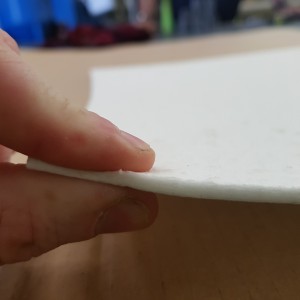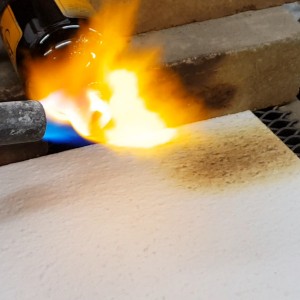One of the main problems generally encountered when searching for a high temperature insulation material is that in order to withstand elevated temperatures, a trade-off is usually made with mechanical strength resulting in materials that are brittle, porous, fibrous and generally difficult to handle. If these properties are what are causing trouble in your high temperature insulation application, then you may want to read on and find out more about AG’s Lytherm Ceramic Insulation Paper.
Really, a heat resistant paper?
We know it sounds strange but Lytherm isn’t your normal paper manufactured from organic tree wood. It’s actually manufactured from high purity alumina-silicate fibres. These are ceramic-based inorganic fibres that are often used as a refractory material in many high temperature industrial applications and processes where temperatures reach over 1000ºC.
The fibres are washed and spun in a special process to remove foreign particles and to control the content of unfiberized shot. The resulting product is a thin, white sheet material that is lightweight but strong.

What are the advantages of ceramic fiber paper?
Ceramic Insulation Papers offer many advantages over other forms of insulation. They are thin, flexible and lightweight while still able to remain extremely stable and easy to handle. Lytherm is so stable that even when exposed to water, steam or oil it will return to its original thermal and physical properties upon drying!
Lytherm also exhibits extremely low thermal conductivity and heat storage. This makes it particularly useful for heat containment in tight places or where a uniform thickness material is required. It is also resistant to a wide range of chemicals meaning it can be used in a diverse range of applications.
Other benefits include:
- Excellent compression recovery (very important for sealing).
- Good dielectric strength.
- Low heat storage.
- Very little shrinkage. Even at extreme temperatures.
Best of all it can be cut into shapes, wrapped, formed or slit into rolls without falling to pieces. This means you can achieve the exact shape of insulator that you require.

Where is ceramic insulation paper typically used?
Ceramic insulation papers are mainly used as lining materials, for high temperature seals, primary insulation or as a filler. Within these broad descriptions, there’s a lot of specific uses. Just some of them include:
- Lining of doors and walls for furnaces and kilns.
- Insulation for wood-fired pizza ovens.
- Lining and insulation for glass making.
- Making high temperature gaskets and seals.
- Insulation around engines and exhaust systems in the marine and automotive sectors.
- Pump insulation.
- As a filler for insulation batts and blankets.

These really are just some of the countless applications we’ve seen for Lytherm ceramic paper over the years. If you think Lytherm might be suitable for your application, it’s worth speaking to one of our experienced customer service team members. They’ll be happy to help with information on sizes, fabrication options and anything else you need to know.
Is there anything to be aware of?
Most grades of Lytherm Ceramic Insulation Paper contain a low percentage of organic binder that may burn off when initially exposed to elevated temperatures. In most applications, this should not be a concern – merely something to be aware of.
In applications where this could be an issue, AG can also supply a completely inorganic binderless grade. This specialised type is able to handle temperatures up to 1650ºC whereas the standard grade is rated to a (still fairly impressive) 1260°C.
To find out more about this product including what thicknesses and sizes are available we suggest heading over to the product page on our website where you will be able to find all the technical data. Alternatively, to learn more about all the fabrication options we offer for our Lytherm paper, you can get the details of your local AG branch here.
